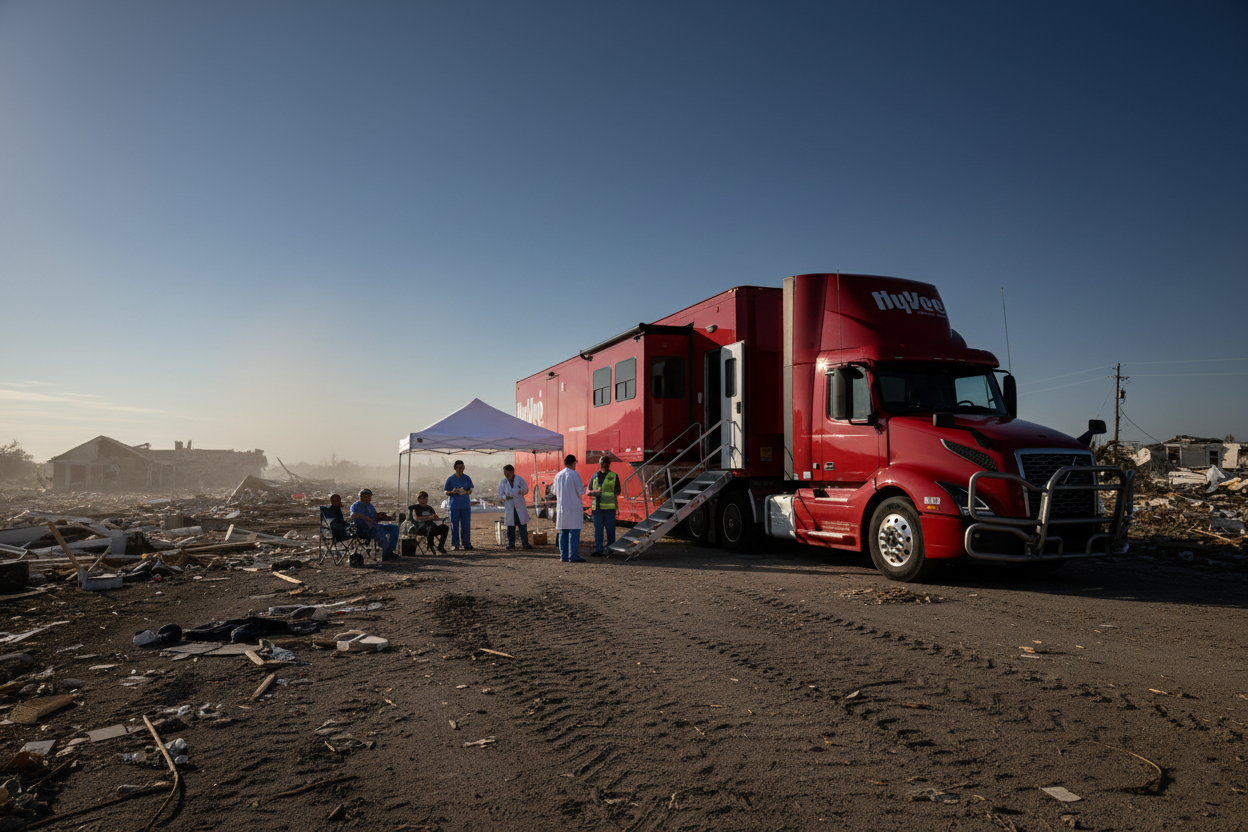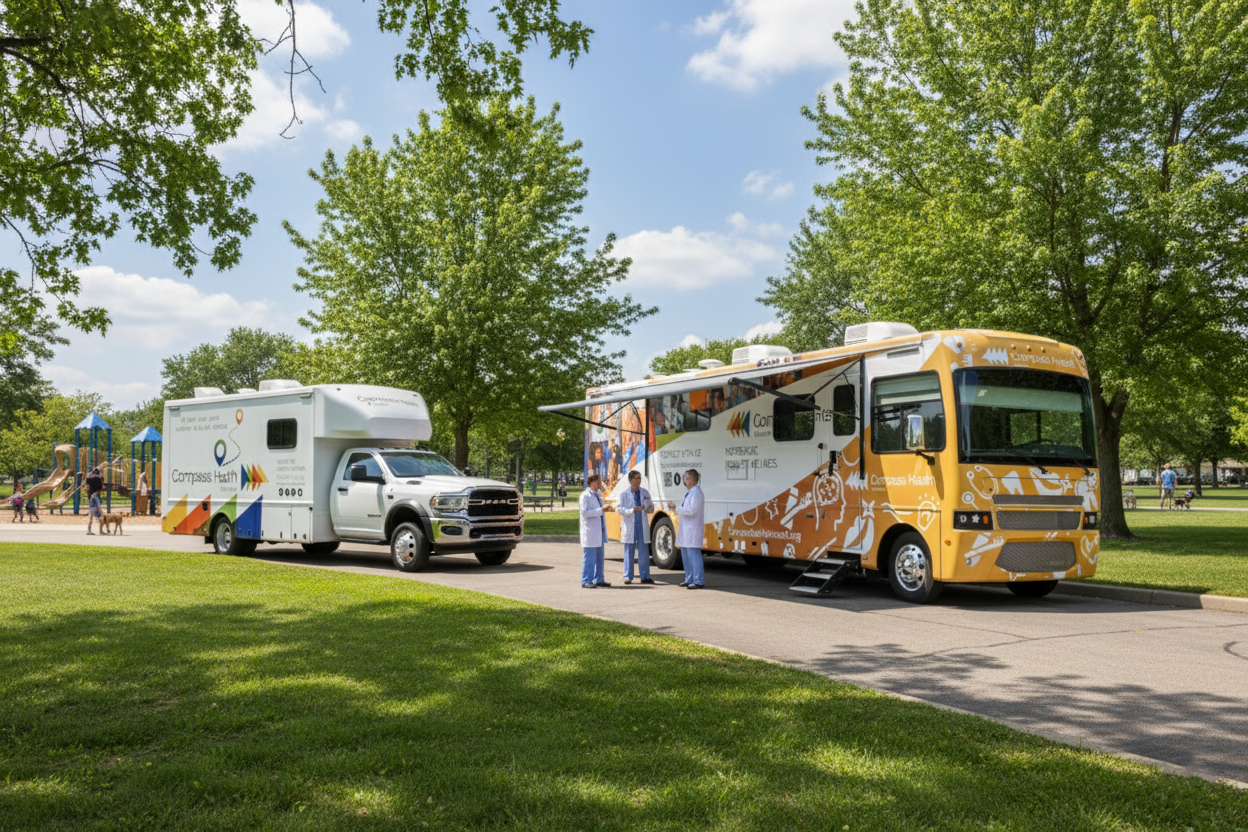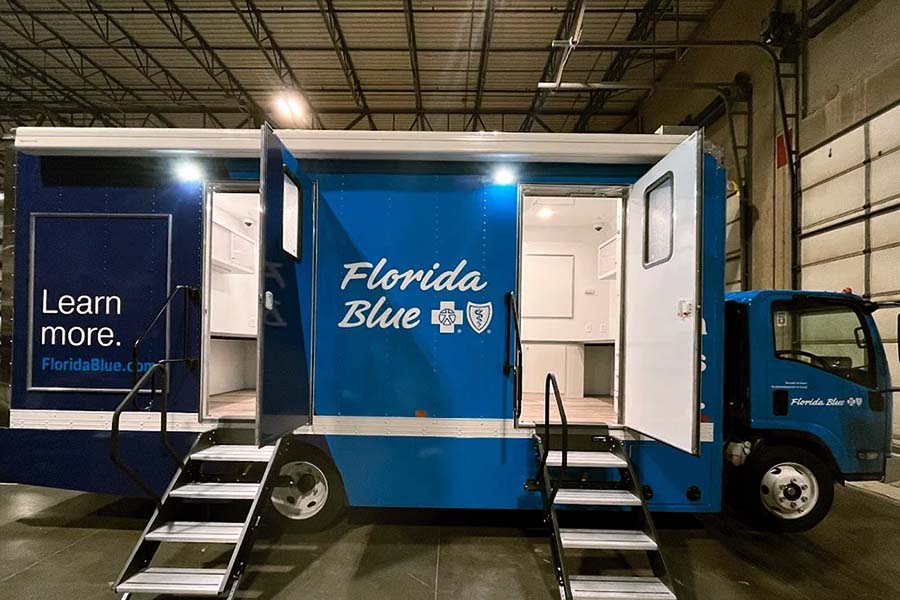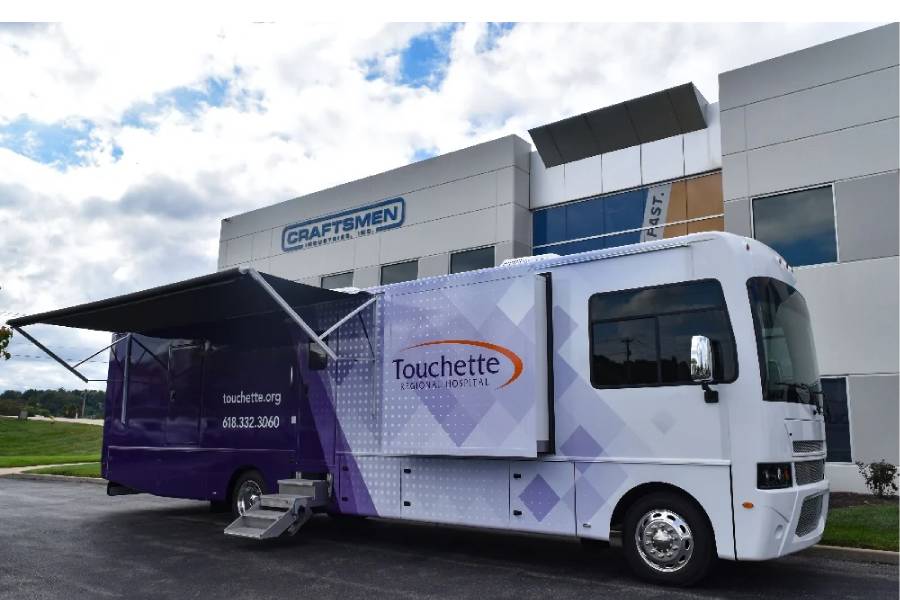Medical Trailers vs. Medical Vans: Why Trailers Are Better
Access to quality healthcare is not evenly distributed, and mobile medical solutions have stepped in to bridge the gap. A medical trailer is a large,...
10 min read
Craftsmen Industries Oct 20, 2025 5:59:22 AM

Medical vehicles, including purpose-built trailers, mobile clinics in RVs, and heavy-duty trucks (excluding vans), are transforming healthcare delivery in remote and hard-to-reach regions. They are equipped to provide primary care, diagnostics, preventive screenings, and emergency stabilization, functioning almost like “hospitals on wheels.” The need is urgent: only 72% of the most rural U.S. counties had a hospital in 2017, leaving nearly one-third of the population without direct access to inpatient services.
For residents in these underserved areas, travel distances, cost barriers, and emergency delays can mean the difference between timely care and preventable complications. By bringing services directly to patients, medical vehicles reduce disparities and strengthen community resilience during natural disasters, disease outbreaks, or mass-casualty events.
This guide explores their real-world applications in rural healthcare and emergency response.
Rural and remote communities often face persistent challenges in accessing medical services. Hospitals are scarce, physician shortages are widespread, and many counties are designated healthcare deserts.
According to the Health Resources & Services Administration (HRSA), nearly 75 million Americans reside in primary care shortage areas, with a significant proportion located in rural counties. The nearest hospital may require an hour or more of travel for many residents, creating barriers to preventive care and urgent treatment.
These challenges are magnified during emergencies. Rural hospitals close at higher rates than urban ones, leaving communities vulnerable in natural disasters or disease outbreaks. In such circumstances, medical vehicles provide an essential bridge.
Mobile medical vehicles can quickly reach rural, isolated populations, restore healthcare access, and operate even when local infrastructure is damaged. In short, they act as mobile hospitals, delivering stability and continuity of care where needed.
Mobile healthcare vehicles are versatile, adaptable, and designed to meet the unique medical needs of rural communities. Below are the core applications that demonstrate how they bring essential healthcare directly to people who would otherwise lack access to it.

In many rural counties, residents must travel long distances for something as simple as a check-up. This creates delays in care, particularly for individuals with chronic conditions. Mobile trailers and RV-based clinics make a difference by providing comprehensive outreach programs. These programs include routine physicals that enable patients to monitor their overall health, chronic disease management for conditions such as diabetes or hypertension, and preventive care, including blood pressure and cholesterol screenings.
By bringing these services directly into rural neighborhoods, medical vehicles reduce time and cost barriers while helping communities maintain consistent health oversight.
Mobile diagnostic and screening services are vital for catching diseases before they become severe. However, rural patients often lack access to specialized equipment. Mobile healthcare vehicles are equipped to provide these critical services close to home. They can deliver mammography screenings to detect breast cancer at an early stage. They also conduct blood tests to identify infections or chronic issues.
Additionally, they conduct audiometric testing to monitor hearing loss in agricultural workers. Vision exams are also offered, helping to catch conditions such as cataracts or glaucoma. Each of these services significantly improves the chances of early intervention, reducing long-term health risks and costs.
Maternal and pediatric care shortages are among the most urgent issues in rural areas. A March of Dimes report shows that over one-third of U.S. counties are now classified as maternity care deserts, meaning they have no birthing facilities or obstetric clinicians. Mobile maternal health units directly address this need.
They provide prenatal visits that monitor maternal and fetal health, postnatal checkups to ensure safe recovery, and vaccinations that protect infants and children from preventable diseases. These services are especially vital in reducing infant mortality rates, which remain higher in rural communities compared to urban areas.
Healthcare access is an individual concern and a community and workplace challenge. Rural employers, schools, and farming cooperatives often struggle to provide regular health support for their members. Mobile wellness clinics bring care directly to these groups.
For example, large agricultural employers can schedule on-site visits where employees receive health checkups and education about occupational risks.
Schools can host vaccination drives and mental health awareness programs to promote overall well-being. Community events can include seasonal mobile wellness campaigns, such as flu prevention clinics. These initiatives enhance overall health literacy, promote preventive practices, and mitigate disruptions caused by untreated conditions.

In emergencies, access to immediate and reliable healthcare can determine survival outcomes. Fixed hospitals may be damaged, overwhelmed, or too far away, especially when transportation networks are disrupted. Mobile medical trailers offer a crucial alternative, as they can be deployed within hours, are self-sufficient, and function as fully functional care units. Their mobility makes them essential in reaching displaced populations, disaster-stricken regions, and frontline responders.
Below are the core ways they are applied in emergency contexts.
Natural disasters often create sudden surges in medical demand. Earthquakes, floods, hurricanes, and wildfires can devastate local infrastructure, leaving thousands without access to medical care. In such situations, mobile healthcare vehicles act as the “first layer of response.”
For example, during Hurricane Wilma in 2005, the U.S. Public Health Service deployed nine mobile medical vans across Broward County, Florida. These units provided essential care to retirement communities and low-income housing where residents had been cut off from clinics and pharmacies due to prolonged power outages.
Similarly, the WHO deploys mobile clinics worldwide during humanitarian crises, sending them by vehicle, boat, or foot into refugee camps and conflict areas to deliver primary care, vaccinations, and maternal health services.
These clinics typically provide wound care, basic surgical services, mental health support, and medications for chronic diseases. They are often the first point of contact for medical assistance after disasters. By reaching isolated populations quickly, mobile clinics bridge the dangerous gap between disaster onset and the restoration of fixed healthcare systems.
Mobile healthcare is crucial in supporting military operations, large-scale emergencies, and mass casualty incidents. They serve as field hospitals, triage points, and command units that integrate directly with rescue operations.
For instance, Disaster Medical Assistance Teams (DMATs) in the U.S. are federally organized groups that deploy mobile field hospitals within 72 hours. During Hurricane Katrina, DMATs were instrumental in treating patients in New Orleans when hospitals were damaged and overwhelmed.
Globally, mobile innovations are advancing rapidly. The Bhishma Cube, developed in India, can be dropped by helicopter or parachute into disaster zones. It can treat around 200 patients daily, perform 10–15 surgeries, and is self-sufficient in terms of solar and generator power. A newer version, the BHISMCUBE, can be set up in as little as 12 minutes, using 72 RFID-tagged boxes containing modular medical supplies.
Such systems include medical facilities and operational hubs that coordinate with first responders and help stabilize patients before transferring them to permanent hospitals.
Pandemics underscore the need for flexible and scalable healthcare delivery. Mobile units proved indispensable during the COVID-19 pandemic, where the virus’s rapid spread demanded widespread testing, vaccinations, and temporary isolation facilities.
The FEMA Mobile Vaccination Units are a prime example. FEMA partnered with state and local governments to deploy buses, RVs, and trailers as vaccination centers, moving them daily to reach high-demand and underserved communities. These units provided equitable access in rural and urban “vaccination deserts,” ensuring millions received timely immunizations.
Mobile units also played a role in testing and treatment. In several countries, isolation trailers were deployed to house patients with suspected or confirmed COVID-19, thereby preventing further transmission of the disease. Disaster Medical Assistance Teams were redirected to support overburdened hospitals, staff vaccine drives, and even set up monoclonal antibody clinics.
These identical vehicles can be adapted for future outbreaks of influenza, Ebola, or infectious disease. Their portability and modular design make them vital tools for controlling epidemics before they spread widely.
The effectiveness of mobile healthcare in emergencies lies in its unique advantages. Unlike temporary tents or overwhelmed local clinics, medical trailers are designed for resilience and adaptability. Here are some benefits of using medical trailers:

Case studies highlight these benefits clearly:
While mobile medical trailers are indispensable in disaster relief, rural healthcare, and underserved regions, they also face apparent limitations. Understanding these challenges is critical for policymakers, healthcare providers, and aid organizations who rely on them.
The main issues include logistics, staffing shortages, equipment maintenance, and unstable funding streams. Each obstacle affects the efficiency and sustainability of mobile healthcare programs; however, innovative strategies are emerging to mitigate these challenges.
The first challenge lies in logistics. Deploying medical trailers requires secure transport routes, fuel availability, and accessible staging sites. In rural America, for example, nearly 80% of counties are classified as medically underserved, and many of these areas lack the necessary infrastructure to easily host large mobile units. Dirt roads, flood-prone terrain, and limited electrical hookups complicate rapid deployment.
Trailers become even more difficult when roads are damaged or blocked during disasters. This means logistical planning must include backup transport, modular designs for quick setup, and coordination with local emergency response systems. Without this planning, even the best-equipped trailers risk being stranded when needed most.
Another significant limitation is staffing. Mobile units cannot operate effectively without physicians, nurses, technicians, and administrative staff who are trained in high-mobility settings. Yet, healthcare staffing shortages are already severe: the U.S. is projected to face a shortage of up to 124,000 physicians by 2034.
Recruiting skilled staff for mobile duty, often in rural or high-risk environments, adds another layer of difficulty. Providers must be flexible, adapt to limited equipment, and be willing to work long hours under pressure. Training and retaining such personnel requires additional funding and support, which many programs lack.
Unlike permanent hospitals, mobile trailers are exposed to constant wear and tear from transportation and the frequent setup and takedown process. Generators, HVAC systems, water supplies, and specialized medical equipment require regular servicing. Breakdowns not only interrupt care but can also compromise patient trust and confidence.
Moreover, trailers often operate as short-term solutions. Patients may receive immediate treatment but struggle with continuity of care once the trailer leaves. A study published in the International Journal of Equity in Health found that fragmented referral systems in mobile clinics often result in lower follow-up rates for patients with chronic diseases.
This suggests that while trailers can address acute needs, integrating them into the healthcare system on a long-term basis is more challenging to achieve.
One of the biggest obstacles is financial support for mobile medical programs. Trailers cannot rely on high patient volumes or extensive billing, unlike hospitals. According to a study on mobile clinics in the U.S., 52% of funding comes from philanthropy, while 45% depends on federal support. Direct patient revenue covers only a fraction of expenses.
This heavy reliance on grants and donations makes programs vulnerable to interruptions. During the COVID-19 pandemic, for instance, many mobile units had to pause operations due to reduced funding and safety restrictions. Long-term sustainability requires diversified revenue streams, integration into Medicaid/Medicare reimbursement, and inclusion in national emergency preparedness budgets.
Even when trailers reach their destination, integration with local healthcare systems is not automatic. Data sharing with hospitals, lab testing capacity, and electronic health records often remains disconnected. Without strong referral pathways, patients who need specialty or follow-up care may fall through the cracks.
The National Library of Medicine has noted that mobile health units are most effective when paired with structured referral and patient navigation systems, but such coordination is resource-intensive. Bridging this gap is crucial to avoid duplicating services or providing temporary relief that has no long-term impact.
Despite these limitations, progress is being made. FEMA, for example, deploys modular, mobile medical stations that can be quickly scaled up or down depending on the size of the disaster response, thereby reducing some logistical barriers.
Health systems are investing in hybrid care models that combine mobile trailers with telemedicine and digital record-keeping, ensuring continuity of care even when the trailer’s not present. To address funding instability, several states are exploring reimbursement models that classify mobile clinics as eligible providers under Medicaid, which could stabilize finances and expand reach.
Mobile medical trailers significantly reduce travel barriers for patients in underserved regions. In many rural U.S. counties, residents live more than 30 miles from the nearest hospital. Mobile units minimize travel times and encourage regular checkups by bringing primary care, screenings, and preventive services to communities.
Yes. These units are designed for flexibility and rapid deployment in disaster-hit regions. During Hurricane Katrina, the American Red Cross and FEMA deployed mobile clinics to deliver first aid, triage, and vaccination services where hospitals were destroyed or inaccessible. Similar setups have been employed globally in earthquake-affected zones and flood-prone areas, demonstrating their value in disaster relief and humanitarian aid.
Deployment timelines vary depending on the size, equipment, and logistical support required. Smaller mobile clinics can be operational within 12 to 24 hours, while larger, fully equipped medical trailers, such as modular emergency stations, may take 1 to 3 days to set up. This speed allows them to serve as the first line of care before permanent facilities recover or expand capacity during surges.
Yes, mobile healthcare vehicles are not just stop-gap solutions. They provide ongoing primary care, chronic disease management, and preventive health services. They are particularly effective in providing continuity of care for conditions such as diabetes, hypertension, and maternal health.
Medical trailers are versatile units designed to meet a wide range of healthcare needs. They can be equipped with X-ray or ultrasound machines, onboard labs for rapid testing, and triage setups for emergency response. Many also include pharmacy storage for essential medicines and telemedicine tools for remote consultations. Depending on the situation, this flexibility allows them to function as anything from a primary care clinic to a field hospital.
Medical vehicles are critical in bridging healthcare gaps for rural communities and saving lives during emergencies. They have proven versatile and life-saving, from providing routine checkups and maternal care in underserved regions to serving as mobile command centers during disasters. Their adaptability, whether as diagnostic units, vaccination hubs, or fully equipped field hospitals, ensures that care can be delivered wherever it is needed most.
At Craftsman Industries, Inc., we specialize in designing and building Medical Trailers and Emergency Vehicles tailored to real-world healthcare challenges. Our solutions prioritize flexibility, compliance, and durability, providing healthcare providers with the tools to serve their communities effectively.
If your organization is ready to expand access to care or strengthen its emergency response capacity, explore our Medical Trailers and Emergency Vehicles to see how Craftsman Industries, Inc. can partner with you in making healthcare more accessible and resilient.

Access to quality healthcare is not evenly distributed, and mobile medical solutions have stepped in to bridge the gap. A medical trailer is a large,...

Innovations have revolutionized healthcare access in remote areas, with mobile medical vehicles utilizing advanced technology to bridge gaps in...

Many people struggle with getting adequate medical care due to their circumstances. While some may find it difficult to find a medical facility due...